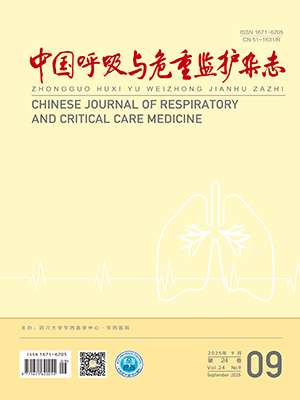| 1. |
Joseph A, Petit M, Vieillard-Baron A. Hemodynamic effects of positive end-expiratory pressure. Curr Opin Crit Care, 2024, 30(1): 10-19.
|
| 2. |
Fossali T, Pavlovsky B, Ottolina D, et al. Effects of Prone position on lung recruitment and ventilation-perfusion matching in patients with COVID-19 acute respiratory distress syndrome: a combined CT scan/electrical impedance tomography study. Crit Care Med, 2022, 50(5): 723-732.
|
| 3. |
卢岩, 涂学平, 马超, 等. 床旁超声指导下肺保护通气对ARDS患者氧合指数的影响研究. 临床肺科杂志, 2021, 26(6): 896-900.
|
| 4. |
Nakayama R, Bunya N, Katayama S, et al. Correlation between the hysteresis of the pressure-volume curve and the recruitment-to-inflation ratio in patients with coronavirus disease 2019. Ann Intensive Care, 2022, 12(1): 106.
|
| 5. |
The ARDS Definition Task Force, Ranieri VM, Rubenfeld GD, et al. Acute respiratory distress syndrome: the Berlin Definition. JAMA, 2012, 307(23): 2526-2533.
|
| 6. |
罗前程, 刘瑞, 曲凯丽, 等. 即时肺部超声结合压力-容积曲线设定PEEP对ARDS肺复张的临床评价. 宁夏医科大学学报, 2021, 43(1): 22-28.
|
| 7. |
刘天亚, 乔惠婷, 许丽嫱, 等. 基于肺的静态压强—容积曲线估计肺复张特性的研究. 生物医学工程学杂志, 2021, 38(2): 326-332.
|
| 8. |
陈佳祥, 史晓莉, 梁昌盛, 等. 肺动态顺应性导向呼气末正压滴定法用于肺保护性通气策略的研究进展. 临床麻醉学杂志, 2023, 39(9): 987-990.
|
| 9. |
Grasselli G, Calfee CS, Camporota L, et al. European Society of Intensive Care Medicine Taskforce on ARDS. ESICM guidelines on acute respiratory distress syndrome: definition, phenotyping and respiratory support strategies. Intensive Care Med, 2023, 49(7): 727-759.
|
| 10. |
Taenaka H, Yoshida T, Hashimoto H, et al. Personalized ventilatory strategy based on lung recruitablity in COVID-19-associated acute respiratory distress syndrome: a prospective clinical study. Crit Care, 2023, 27(1): 152.
|
| 11. |
Cammarota G, Bruni A, Morettini G, et al. Lung ultrasound to evaluate aeration changes in response to recruitment maneuver and prone positioning in intubated patients with COVID-19 pneumonia: preliminary study. Ultrasound J, 2023, 15(1): 3.
|
| 12. |
Kowalczyk D, Turkowiak M, Piotrowski WJ, et al. Ultrasound on the frontlines: empowering paramedics with lung ultrasound for dyspnea diagnosis in adults-a pilot study. Diagnostics(Basel), 2023, 13(22): 3412.
|
| 13. |
Capasso L, Pacella D, Migliaro F, et al. Can lung ultrasound score accurately predict surfactant replacement? A systematic review and meta-analysis of diagnostic test studies. Pediatr Pulmonol, 2023, 58(5): 1427-1437.
|
| 14. |
王旭东, 孙延虎, 刘雅文, 等. 床旁超声对ARDS患者肺复张后的最佳PEEP设置探讨. 中国卫生标准管理, 2023, 14(22): 108-111.
|
| 15. |
Bouhemad B, Brisson H, Le-Guen M, et al. Bedside ultrasound assessment of positive end-expiratory pressure-induced lung recruitment. Am J Respir Crit Care Med, 2011, 183(3): 341-347.
|
| 16. |
丁媛, 倪佳园, 徐荣鹏, 等. 肺部超声在重症患者的应用及研究进展. 中国呼吸与危重监护杂志, 2021, 20(7): 522-527.
|
| 17. |
李根, 荣令, 赵美景, 等. 床旁超声导向的最佳呼气末正压对急性呼吸窘迫综合征患者氧合指数及血流动力学的影响研究. 中国全科医学, 2019, 22(5): 616-620.
|
| 18. |
程江丽, 杨杰, 康焰. 急性呼吸窘迫综合征机械通气患者呼气末正压设定的方法. 中国呼吸与危重监护杂志, 2019, 18(6): 591-594.
|
| 19. |
Roldán R, Barriga F, Villamonte R, et al. The use of the oxygenation stretch index to predict outcomes in mechanically ventilated patients with COVID-19 ARDS. Respir Care, 2023, 68(12): 1683-1692.
|
| 20. |
Formenti P, Graf J, Santos A, et al. Non-pulmonary factors strongly influence the stress index. Intensive Care Med, 2011, 37(4): 594-600.
|
| 21. |
Plataki M, Hubmayr RD. Should mechanical ventilation be guided by esophageal pressure measurements? Curr Opin Crit Care, 2011, 17(3): 275-280.
|
| 22. |
韩宇, 陈军, 范凤尾, 等. 跨肺压导向滴定呼气末正压治疗ARDS的疗效及安全性的Meta分析. 现代临床医学, 2023, 49(1): 47-51.
|
| 23. |
狄萍萍, 王晋平. 跨肺压滴定个体化呼气末正压对行腹腔镜结直肠癌根治术患者肺功能的影响. 新乡医学院学报, 2023, 40(8): 779-783,790.
|
| 24. |
Mongodi S, De Luca D, Colombo A, et al. Quantitative lung ultrasound: technical aspects and clinical applications. Anesthesiology, 2021, 134(6): 949-965.
|




